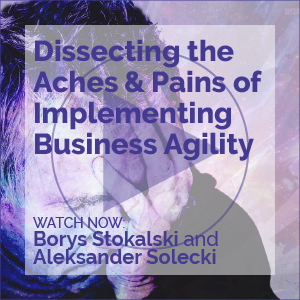February 2001 Component Development Strategies
AI and E-Commerce
Last summer, Cutter Consortium Senior Consultant Paul Harmon posed the question, "Is it too early to start talking about 'Intelligent E-Business Applications?'" in his Distributed Computing Architecture/e-Business E-Mail Advisor, " Artificial Intelligence Lives" (2 August 2000).
AI and E-Commerce
The idea of artificial intelligence (AI) has been around for a long time. Its roots are in the world of mathematics, yet AI also has a long history in the field of computer science. AI (the artificial creation of all aspects of life) has been seen as a daring concept but, in reality, AI is used routinely today by more people than ever before.
BPR for E-Business
I recently got into a long discussion with some folks from IBM and Sun Microsystems about e-business development and what is actually happening at large corporations.
Rethinking Component-Based Development
A component is a piece of software with a standardized runtime interface. Components may consist of a few classes that perform simple, atomic level functions, or they may consist of hundreds of classes that perform entire business processes.
Intelligent Agents Catching On
In the Distributed Computing Architecture/e-Business Executive Report, " AI and E-Commerce" (Vol. 4, No. 2), author Jesse Feiler discussed the status of artificial intelligence (AI) in today's e-commerce activities, noting that AI interacts with e-commerce in three ways:
Visualizing Success
Tools that allow users to apply advanced data visualization techniques have been around for years. For the most part, however, these tools have been used in scientific and engineering domains to build models for fluid flow analysis, aerodynamic simulation, interpreting atmospheric data, genetic mapping, and other complex applications involving extremely large data sets with many cause-and-effect variables.
Visualizing Success
Tools that allow users to apply advanced data visualization techniques have been around for years. For the most part, however, these tools have been used in scientific and engineering domains to build models for fluid flow analysis, aerodynamic simulation, interpreting atmospheric data, genetic mapping, and other complex applications involving extremely large data sets with many cause-and-effect variables.
Sagent: Driving EAI and BI at Tickets.com
It is way past the point when you would need to describe data warehousing and business intelligence (BI) applications in order to prove the technology works or to prove the value of enterprise data integration -- most organizations are convinced.
nQuire Answers
In last month's BIA, I said that we are now witnessing the application of advanced technologies for enhancing the search-and-retrieval capabilities of BI applications. In this vein, nQuire Software, Inc. has added an English language search capability to its nQuire Suite search, analysis, and content aggregation tool.
Vendor Contact Information
February 2001 Business Intelligence Advisor
In the January 2001 BIA, I stated that organizations can apply advanced data visualization to enhance their business intelligence (BI) efforts. Advanced data visualization is useful for supporting analysts and other power users with traditional BI applications such as online analytical processing, data mining, and statistical analysis.
Toward Survivable COTS-Based Systems
The environment in which software projects are developed and managed has evolved dramatically in recent years. This evolution has been driven by an extraordinary increase in network connectivity and extensive use of contractors for system development, raising issues of interoperability, security, ownership, and intellectual property rights.
An Ounce of Prevention and a Pound of Cure: Taking a Comprehensive Approach to Information Risk Management
Corporations have increased their investment in information security, as critical business systems have moved into increasingly hostile territory. Gradually, as the enterprise has embraced new technologies such as EDI/EFT, remote access, and sales automation, confidential data has found itself in ever-riskier venues. Moving to the Internet is the latest -- and riskiest -- frontier.
It's About Time: Can We Actually Measure Information Security?
This article is based upon the book Time Based Security by Winn Schwartau (Interpact Press, 1999).
Bridging E-Business and Added Trust: The Keys to E-Business Growth
Do you trust the Internet enough to send your life's savings to your business partner electronically? How much would you be willing to risk? Are you sure whom you are communicating with at the other end of the line? These are the questions one must answer for electronic commerce to flourish.
Applying Aspect-Oriented Programming to Security
Aspect-oriented programming (AOP) is a new programming paradigm that explicitly promotes separation of concerns. In the context of security, this would mean that the main program should not need to encode security information; instead, it should be moved into a separate, independent piece of code.
Applying Aspect-Oriented Programming to Security
Aspect-oriented programming (AOP) is a new programming paradigm that explicitly promotes separation of concerns. In the context of security, this would mean that the main program should not need to encode security information; instead, it should be moved into a separate, independent piece of code.
Methodologies and Requisite Variety
On-time delivery 99.5% of the time would be wonderful -- right? Improved morale would lead to better staff retention and higher productivity -- right?
Extreme Project Management
"A good plan today is better than a perfect plan tomorrow."
-- Conrad Brean (played by Robert De Niro in the 1997 movie Wag The Dog)
Extreme Project Management
There are three major forces driving the need for a new paradigm of project management.
Immature Project Management Practices Lead to Delays and Expense on E-Projects
There are two main requirements for the success of e-projects: alignment with business needs and rapid low-cost delivery. Both can be achieved through effective project management practices. On e-projects, alignment means achieving effective and rapid-response requirements management. Cost reduction implies proper mechanisms for planning and control, which ensure early visibility and near-optimal use of resources.
Extreme Project Management
"A good plan today is better than a perfect plan tomorrow."
-- Conrad Brean (played by Robert De Niro in the 1997 movie Wag The Dog)
Extreme Project Management
"A good plan today is better than a perfect plan tomorrow."
-- Conrad Brean (played by Robert De Niro in the 1997 movie Wag The Dog)







